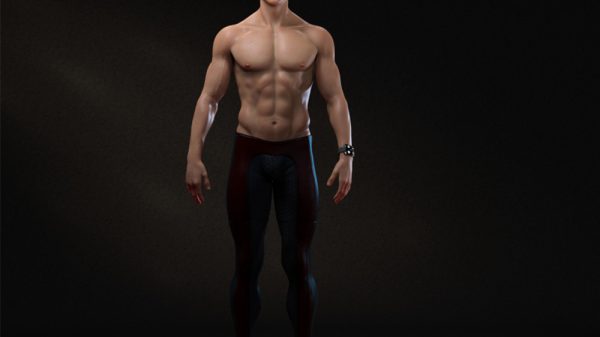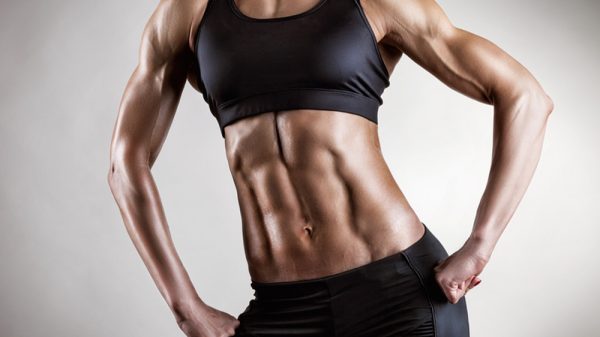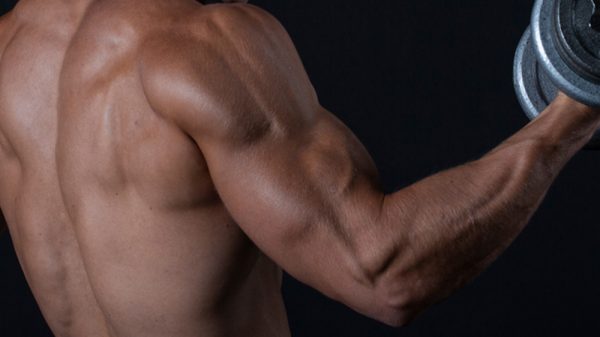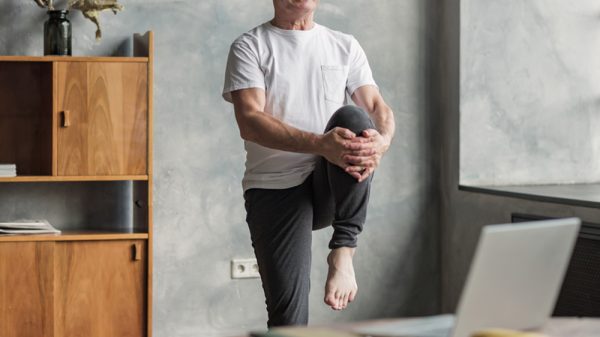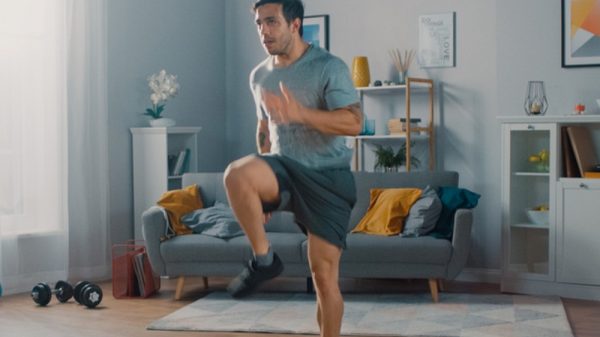If you’re new to high-intensity interval training (HIIT) workouts, it can be difficult to know where to begin. HIIT is growing in popularity and is revered for its ability to expedite fat loss and facilitate muscle growth. So how do you do a HIIT workout? Keep reading to find out tips for completing HIIT workouts, as well as two planned HIIT workouts for beginners.
The Scoop on HIIT Workouts: Why Are They So Popular?
HIIT workouts are trending right now for a pretty good reason. HIIT is part of a broader form of exercise called metabolic training, which is a form of training that aims to improve your metabolism and has shown promise in fighting metabolic conditions like insulin resistance and obesity.
HIIT aims to boost your metabolism for hours following the end of your workout, meaning your fat-burning and muscle-building capacity is higher.
HIIT workouts are also really popular because they are efficient. HIIT workouts are quick workouts, and you can be in and out of the gym in 45 minutes or less while feeling like you’ve had a 90-minute workout.
The Importance of Warming Up
Before diving into a HIIT workout, always make sure to do a few minutes of warm-ups first. Warming up allows your muscles and ligaments to stretch before engaging in more strenuous activity, while also getting the heart pumping and blood flowing. Adequate warm-ups before intense workouts help prevent injury.
A number of moves serve as good warm-up activities. Before your workout, warm up with 60 seconds each of side lunges, jumping jacks, and walking toe touches. Following your workout, incorporate a cool-down routine that includes one minute of light jogging, followed by two minutes of walking.
Layout of a HIIT Workout
After your warm-ups, aim to complete three repetitions of each exercise to create a set. Each repetition will include a period of exertion and a period of rest. The length of the intervals of exertion and rest can vary based on your strength and fitness level. Just make sure that the rest period is no longer than half of the exertion period. For example, for one repetition, you could engage in 60 seconds of exertion followed by 30 seconds of rest.
When switching from one exercise to the next exercise, give yourself no longer than the allotted rest period that you use in between repetitions. Running through all sets in this manner is called a superset. The number of exercises and supersets you complete really depends on the amount of time you have for your workout.
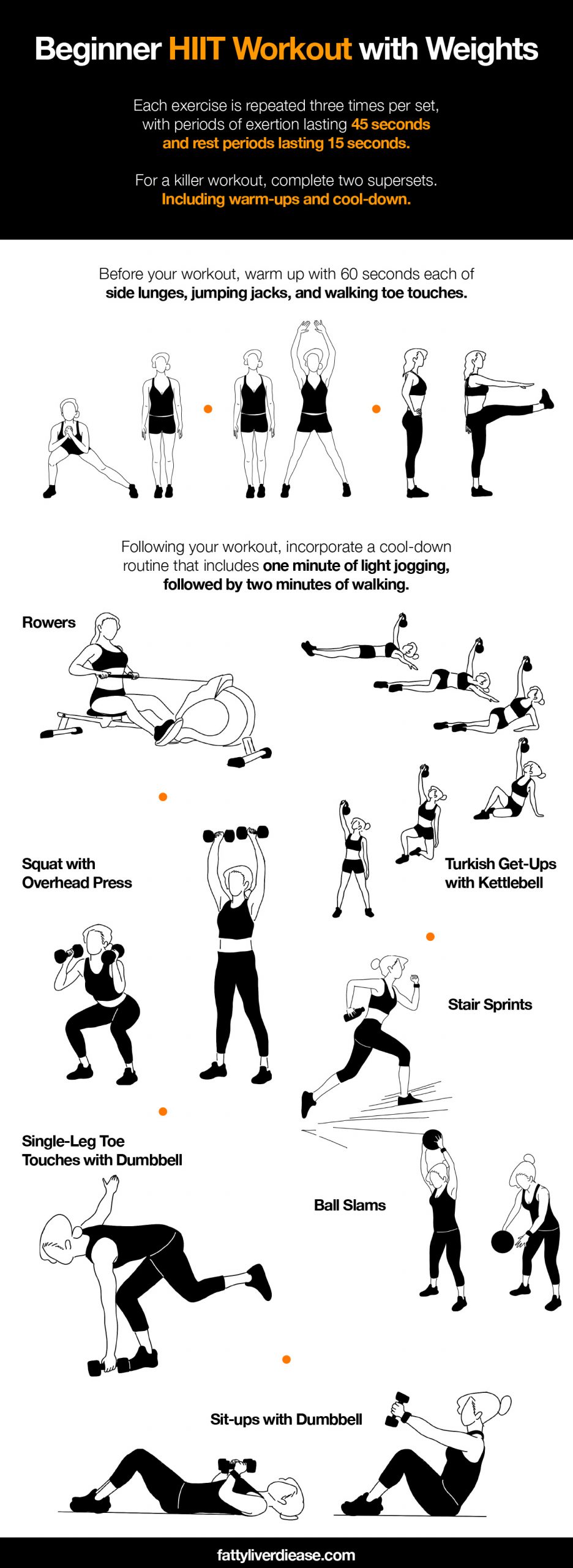
Beginner HIIT Workout with Weights
When incorporating weights into your HIIT workout, you begin to get into metabolic resistance training territory. Generally, metabolic resistance training will be combined with cardio to yield a comprehensive, full-body HIIT workout.
This workout is designed so that each exercise is repeated three times per set, with periods of exertion lasting 45 seconds and rest periods lasting 15 seconds. This means that each exercise will take about three minutes to complete. For a killer workout, complete two supersets. Including warm-ups and cool-down, the entire workout will take almost exactly 45 minutes.
1. Rowers
To do this exercise, start by assuming a shallow squat position while hinging at the hips and keeping your back straight. Holding a dumbbell in each arm, outstretch the arms and pull back, challenging the shoulders and arms. Repeat as many times as possible.
2. Squat with Overhead Press
This is a dynamic movement that flows through the power in your legs, to your shoulders, and through your arms. Hold dumbbells that are heavy enough to be challenging, but not so heavy that you can’t follow through on the exercise. Hold dumbbells at shoulder height and settle into a low squat. Using the quads, hamstrings, and glute muscles, push upwards into a standing position and lift the dumbbells above your head in one fluid motion. Return the dumbbells slowly to shoulder height and repeat.
3. Single-Leg Toe Touches with Dumbbell
Start out by balancing on one foot and holding a dumbbell in the opposite hand. Hinge at the hips, keeping the back straight and outstretching the other leg behind you, while continuing to balance on one foot. Bring the dumbbell towards the floor, before returning to standing position and repeat. Ideally, you want to complete a balanced exercise for both sides of the body. For each period of exertion, spend roughly 22 seconds balancing on the right foot, followed by 22 seconds balancing on the left foot. Or, for the first superset, complete while balancing on the right foot, and then for the next superset, switch to complete the exercise while balancing on the left foot.
4. Turkish Get-Ups with Kettlebell
A Turkish get-up tests the entire body and is performed while holding a kettlebell weight above the head throughout the movement. Performing a Turkish get-up requires starting by lying down on your back, with one arm outstretched above the head, holding a kettlebell. Bend the knee that is on the same side as the hand holding the kettlebell, while keeping the other leg outstretched. Sit up by hinging at the hips and keeping a straight back. Then assume a kneeling position, and move through to standing position, with the kettlebell sustained above the head. Return, step-by-step, to the initial lying down position, and you’ve completed one full Turkish get-up. As with the single-leg toe touches, you want to complete a balanced exercise for both sides of the body. Complete as many as you can on one side for the first set. For the second set, hold the kettlebell in the other hand and switch which knee is bent and which is outstretched.
5. Stair Sprints and Ball Slams
Stair sprints get the heart rate up and make your quads and glutes burn. Find two or three flights of stairs you can use. Place a weighted ball at the bottom and top of the staircase. To complete a ball slam, start from a squatting position with the ball. In a fluid motion, lift the ball far above your head as you stand on your tiptoes, before slamming the ball as hard as you can onto the ground. To complete one repetition of stair sprints, start with a ball slam at the bottom of the staircase, sprinting up, performing another ball slam, running down, and performing the last ball slam at the bottom of the stairs. Repeat.
6. Sit-ups with Dumbbell
This exercise works the triceps and core. Start by lying on your back, knees bent, holding a dumbbell with both arms outstretched above your head, lying on the ground. With straight arms, lift the dumbbell until positioned in the air above your head, and begin contracting your core to sit up. Slowly retract to your original position and repeat.

At-Home HIIT Workout
If you’re strapped for time and trying to fit in a workout before heading to work, you can complete a HIIT workout right at home. Plus, it’s entirely possible to do an at-home HIIT workout without any weights or equipment, focusing more on cardio and bodyweight exercises instead.
Aim to complete three repetitions of each of the following exercises. Aim for 45 seconds of exertion followed by 15 seconds of rest. Like the last workout, this at-home workout has six sets that last for three minutes each. If you’re short on time, complete one superset for a 24-minute workout including warm-up and cool down.
1. Russian Twists with Cycling Legs
While sitting, straighten your back and lift your knees in the air. While twisting your core, cycle your legs one at a time. If you want to add weight to the Russian twists, hold a couple of books while twisting side to side.
2. Mountain Climbers
Assume the pushup position and bring your knees up to your chest, alternating legs. Alternate legs as quickly as possible.
3. Walking Squats
Assume the squat position while keeping your back straight and hands clasped in front of you. Squat as low to the ground as possible while maintaining good form. Walk back and forth across the room.
4. High Knees
Run in place, aiming to bring your knees up as high as possible. To gauge how high your knees are going, hold out your hands at about waist height. Aim to hit the palms of your hands with your knees.
5. Sprints
Using a treadmill or simply the sidewalk outside, complete intervals of sprints. Make sure to exert as much energy as possible during the sprint.
6. Burpees with Pushups
Assume a pushup position, and complete one pushup before bringing both feet between your arms and jumping as high as you possibly can. Repeat.
Tips for HIIT Beginners
Don’t be afraid to make adjustments! HIIT is all about challenging yourself and building up the strongest version of yourself, in both cardio and strength training.
1. Shorten the Sets
If you need to start out with each set lasting two minutes instead of three minutes, that’s totally fine. Alternatively, you can cut down on the number of seconds of exertion, while lengthening the seconds of rest.
2. Keep Good Form
If you need to google the correct form or attend a class to learn the correct form, go for it! If needed, consult a personal trainer for advice on your form.
3. Make Exercises a Little Easier
For example, if you can’t do a full pushup yet, don’t worry. You’ll get there. Start out by doing pushups with your knees on the ground.
4. Track Your Progress
Keep track of where you start and journal your observations after each workout. By tracking the length of intervals, entire workout time, and how you’re feeling, you’ll be able to register successes and work towards strength and endurance goals.
5. Find a HIIT Buddy
Because the most significant factor in the efficacy of HIIT is intensity, it is crucial to stay motivated. When engaging in HIIT on your own, it can be difficult to push yourself to maximum capacity during the workout. Find a workout buddy to do HIIT training with. You can cheer each other on and motivate each other to keep pushing. Try attending CrossFit or HIIT classes together, learn new exercises, and design new routines.
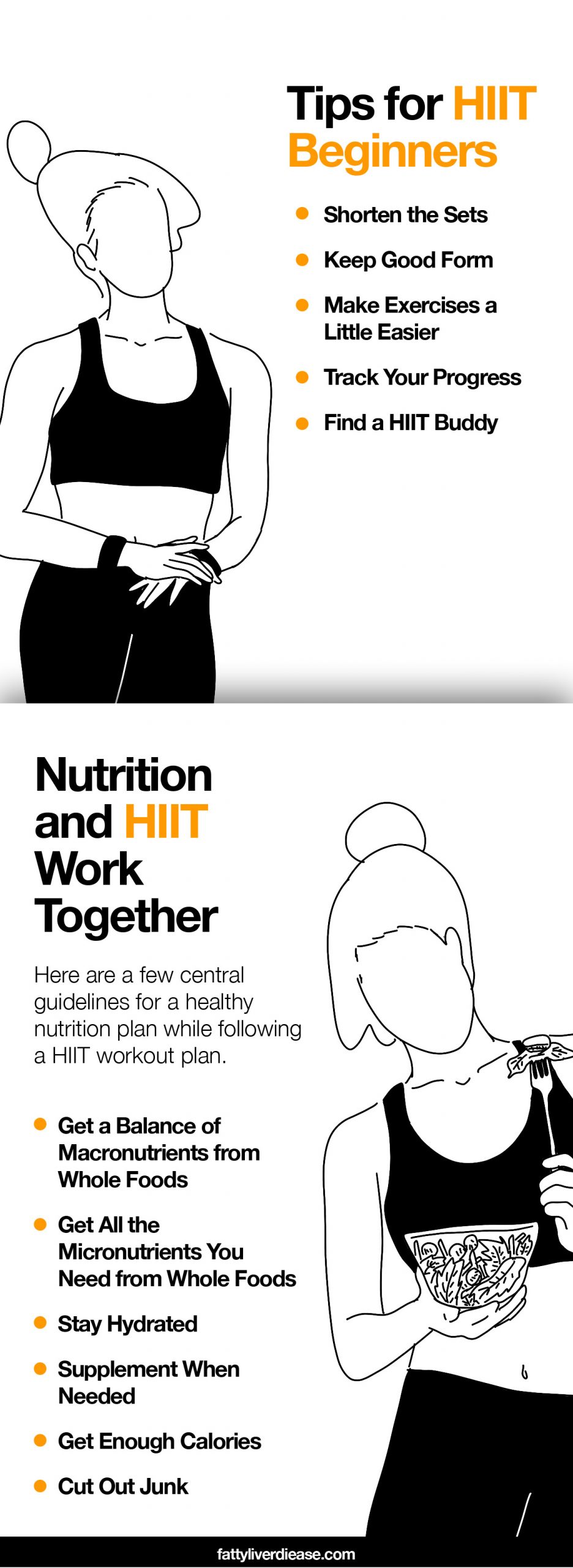
Nutrition and HIIT Work Together
Finally, if you’re not following a good nutrition plan, you won’t get the results that you want from HIIT. HIIT does not work when performed in isolation. Because of the intensity factor in HIIT, nutrition becomes particularly important to fuel maximum performance and optimal recovery. Moreover, if you are living with a metabolic condition like type 2 diabetes, obesity, insulin resistance, or fatty liver disease, nutrition combined with exercise is extremely important for reversing such conditions.
Here are a few central guidelines for a healthy nutrition plan while following a HIIT workout plan.
1. Get a Balance of Macronutrients from Whole Foods
Whole foods refer to any natural food that has not subjected to manmade industrial processes. Macronutrients refer to the major, calorie-contributing compounds we get from food: protein, fats, and carbohydrates. Though fad diets emphasize the efficacy of restricting certain macronutrients, the reality is that your body needs all three macronutrients in balanced proportions to perform optimally.
- Protein: We need amino acids from protein to support immune function and muscle growth. We require ideal ratios of nine essential amino acids from dietary protein sources on a daily basis. When we don’t have enough of just one of these essential amino acids, muscle growth will slow down, and the body won’t be able to repair properly after a HIIT workout. For high-quality proteins, choose lean meats, low-fat dairy, fish, soybeans, tofu, and tempeh. Most vegetable sources of proteins must be combined throughout the day to obtain all essential amino acids.
- Fats: Fat forms the main structural component of cell membranes and is present in all cells throughout the body. Polyunsaturated and monounsaturated fats fortify cell structures and exhibit anti-inflammatory action. Rich sources of healthy fats include nuts, seeds, avocados, and fatty fish. Flaxseeds, chia seeds, walnuts, salmon, and mackerel are filled with omega-3 fatty acids that have particularly potent anti-inflammatory activity.
- Carbs: Carbs have always gotten a bad rap for being the “bad guy” when it comes to weight loss. However, good carbs from whole foods like brown rice, quinoa, sweet potato, and beans fuel workouts and provide the body with sustained energy. The body requires carbs to perform at maximum capacity in HIIT workouts.
2. Get All the Micronutrients You Need from Whole Foods
Micronutrients encompass all of the particles in food that don’t afford calories, like vitamins, minerals, antioxidants, and fiber. Fiber promotes digestive health and liver health, while vitamins and minerals facilitate biological reactions throughout the body. Antioxidants are crucial for relieving oxidative stress, a condition characterized by cellular damage that exacerbates diseases like diabetes and fatty liver. Moreover, antioxidants help your immune system operate efficiently to repair muscle tissues after exercise.
Plant foods like fresh fruits and vegetables are particularly high in micronutrients. To get your micronutrient fix, reach for fresh produce like blueberries, raspberries, strawberries, blackberries, oranges, cherries, watermelon, pomegranate, mango, kale, spinach, collard greens, broccoli, swiss chard, cauliflower, and beets.
3. Stay Hydrated
When you exercise intensely, your body loses water. It’s important to replenish water to keep your blow flow up so that the circulatory system can reach all parts of the body to deliver oxygen and nutrients.
4. Supplement When Needed
Sometimes it difficult to get all the nutrients we need purely from the foods we consume. Depending on your diet and lifestyle, it can be especially difficult to get enough vitamin D and essential amino acids in the diet, both of which are critical for healthy immune function and muscle growth. Adding high-quality supplements to your diet is important for supporting your health and boosting recovery after exercise.
5. Get Enough Calories
In addition to getting high-quality calories, you need enough calories. Without sufficient energy, you won’t be able to perform HIIT at maximum intensity, and your body won’t have enough energy to fuel muscle synthesis. At the same time, if you are striving to lose weight, creating a sustainable calorie deficit between energy consumed and energy burned is important to healthy weight loss.
6. Cut Out Junk
For balanced macronutrients and abundant micronutrients to do their job in the body, you must also cut out all junk foods. Junk foods include processed foods and refined carbohydrates like chips, crackers, cookies, cakes, candy, white bread, white rice, and pastries. These foods interfere with healthy metabolic functioning by spiking blood sugar and leading to weight gain, fatty liver disease, and insulin resistance. Processed meats and dairy products are often high in saturated fats and harmful preservatives that lead to inflammation and further contribute to insulin resistance, weight gain, and fatty liver disease.
Things to Keep in Mind
If you’re new to physical activity, make sure to gradually ramp up your activity level, and don’t dive right into the longest HIIT workout at maximum intensity. Start with shorter HIIT workouts and go from there. If you have a heart condition or another underlying health condition, check in with your doctor to make sure you’re cleared to participate in HIIT.
Conclusion
HIIT workouts are an excellent way to increase your metabolic rate, fat-burning capacity, and muscle growth while improving metabolic conditions. Start out with HIIT workouts for beginners, logging your process, and gradually making changes to challenge yourself. Combined with optimal nutrition, HIIT workouts can yield huge benefits for your health.
